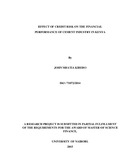| dc.description.abstract | The overall objective of this study was to establish the effects of credit risk on the financial performance of cement firms in Kenya. This was achieved by looking at the effect of credit risk exposure rate, default rate, and recovery rate on the return on asset of cement firms in Kenya. Cross-sectional survey design was used to collect the data from the field. The researcher carried out a census survey where all the listed cement firms and regulated by the Capital Markets Authority as at the time of the study were studied.
Descriptive statistics and inferential analysis of the data were done using measures of central tendency and Pearson correlation analysis. This study induced and actualized better understanding of credit risk effect on cement firms’ performance. Secondary data collected from the cement firms’ quarterly reports for the period 2009 to 2014 was used in this study. The data collected from the annual report was analyzed using the multiple regression analysis. The regression output was obtained using statistical package for social sciences. In the model, the dependent variable return on asset was used as an indicator of financial performance while the independent variables credit risk exposure rate, default rate, and recovery rate were used as credit risk indicators. The findings of the study showed that there is a significant relationship between financial performance and credit risk. The dependent and the independent variables in the study indicated a relationship with credit risk exposure rate and default rate showing a positive relationship with the return on asset while recovery rate showing a negative relationship with return on asset. The regression results shows that exposure rate have a higher significant effect on return on asset than the default rate. The regression results is significant since both the independent variables (ER, DR, and RR) can reliably predict the independent variable return on asset. The study concludes that credit risk exposure rate, default rate and recovery rate have a significant relationship with the return on asset of cement firms in Kenya. The recommendation from the findings of the study suggests that all cement firms in Kenya should implement credit risk measurement system such as credit ranking and credit scoring to customers to avoid incurring more cost on customers who have proved to be not credit worthy. | en_US |

